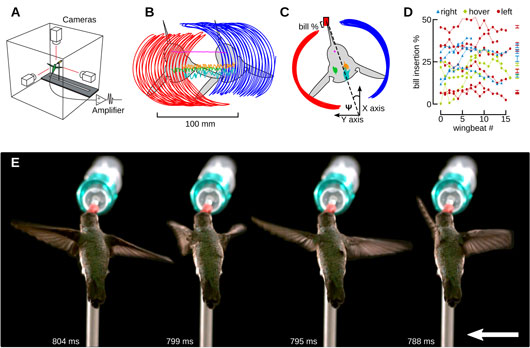To survive in natural environments, animals must be able to respond to unpredictable changes. Having multiple sensory systems provides animals with multiple sources of information about change in their surroundings to facilitate control of behaviors necessary for survival. However, having multiple sources of information also creates a challenge because animals have to evaluate information from the different senses and determine what is relevant for behavior control. A key challenge for understanding behavior control in natural settings is to determine how information from multiple sensory systems is integrated to modify the behavior for changing conditions.
One challenge for animals moving through their environment is controlling their body position in space and relative to obstacles, other animals, and potential sources of food. Behaviors such as hovering to feed from a flower in hummingbirds, require that the hummingbird controls its position relative to the food source, even if the flower or background moves. To complement visual information from the flower and background environment, docking with the flower may give the hummingbird an important source of tactile information, to help maintain contact with the flower required for nectar collection. To investigate how tactile and visual information contributed to hovering control during feeding, we first measured whether hummingbirds have physical contact with the feeder once they dock. We found evidence of contact between the bill and the feeder suggesting tactile information could be available to the hummingbirds.

Figure: Hummingbirds feed from a feeder moving laterally by docking with their bill and angling their wings opposite to the direction of feeder motion. (A) Hummingbirds were studied in an acrylic flight chamber with a feeder that moved left and right along a linear slide. Three high-speed cameras filmed the bird during hovering and feeder tracking to allow kinematic analysis of the hummingbird wingbeats and body motion. (B) Representative data from the top view of a bird moving laterally to the left. The digitized anatomical features presented here are: left wingtip (red), right wingtip (blue), left shoulder (green), right shoulder (orange), head (magenta), and tail (cyan). (C) To compare wingbeats, we used a frame of reference that was aligned to the head marker and the transition points between wing upstrokes and downstrokes. (D) The percentage of the bill inserted into the feeder is plotted across wingbeats for hovering (green), and left (red) and right (blue) lateral flight trials. (E) Time lapse series of images from a single wingbeat during feeder tracking to the left at 15 cm/second. The wingbeat progresses from right to left, starting with the downstroke, and moving to the mid-downstroke, upstroke, and mid-upstroke. The elevated left wing suggests that the hummingbird is producing forces opposite to the direction of feeder motion. Other analyses of wing motions and flow visualization support this prediction.
To investigate whether tactile information was important for controlling docked hovering in a moving environment, we tested two experimental scenarios. In one, we moved the visual background but keep the feeder stationary. Hummingbirds attempted to move to match the visual background. In the other experiment, we moved a feeder laterally in front of a blank visual background. Hummingbirds generated forces opposite to the feeder motion, perhaps attempting to remain stationary instead of following the feeder. These results suggest that hummingbirds to not attempt to maintain a set position relative to the feeder, which contrasts with the strategy of nectar feeding hawkmoths that fly to track feeder motion. Furthermore, it suggests that hummingbirds may not use tactile information to override visual disturbances, although the tactile sense may be more important when the feeder or background motion occurs at different speeds and magnitudes. Our previous Human Frontier Science Program funded studies have shown that hummingbirds are sensitive to visual motion during both undocked hovering (non-feeding)1 and forward flight2, and this new study further supports the primary role of visual information in guiding hummingbird flight, even when tactile information from a target flower is available.
Text by Benjamin Goller
Reference
Visual sensory signals dominate tactile cues during docked feeding in hummingbirds. Goller B, Segre PS, Middleton KM, Dickinson MH and Altshuler DL (2017) Front. Neurosci. 11:622. doi: 10.3389/fnins.2017.00622.
Other references
- Hummingbirds control hovering flight by stabilizing visual motion. Goller B and Altshuler DL (2014) PNAS. 111(51): 18375-18380. doi: 10.1073/pnas.1415975111.
- Visual guidance of forward flight in hummingbirds reveals control based on image features instead of pattern velocity. Dakin R, Fellows TK and Altshuler DL (2016) PNAS. 113(31): 8849-8854. doi: 10.1073/pnas.1603221113.
Other stories from the Altshuler lab


































